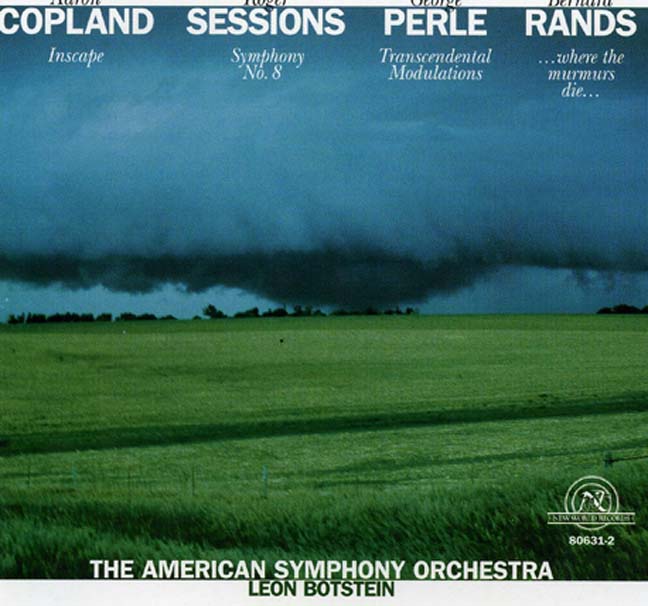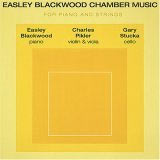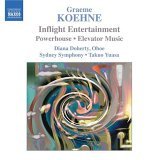| Record companies, artists and publicists are invited to submit CDs to be considered for review. Send to: Jerry Bowles, Editor, Sequenza 21, 340 W. 57th Street, 12B, New York, NY 10019 |
Latest Posts
Ernst Pepping and Allan Pettersson: Moral Dilemmas in Symphonic Music
"The numbers all go to eleven. Look, right across the board, eleven, eleven, eleven and... "
Tell the Birds
Soundtrack to an Apocalypse
Feast Your Ears: New Music for Piano
Gone For Foreign
Fred Lerdahl: Time After Time
Nothing Sacred
Two From Wayne Horvitz
Two Fresh Cantaloupes
Record companies, artists and publicists are invited to submit CDs to be considered for our Editor's Pick's of the month. Send to: Jerry Bowles, Editor, Sequenza 21, 340 W. 57th Street, 12B, New York, NY 10019



|
Archives
Saturday, December 18, 2004
Saturday, December 25, 2004
Friday, December 31, 2004
Wednesday, January 05, 2005
Monday, January 10, 2005
Thursday, January 13, 2005
Thursday, January 20, 2005
Sunday, January 23, 2005
Monday, January 24, 2005
Saturday, January 29, 2005
Wednesday, February 02, 2005
Thursday, February 03, 2005
Monday, February 07, 2005
Tuesday, February 08, 2005
Friday, February 11, 2005
Monday, February 14, 2005
Wednesday, February 16, 2005
Tuesday, February 22, 2005
Monday, February 28, 2005
Sunday, March 06, 2005
Monday, March 07, 2005
Wednesday, March 09, 2005
Sunday, March 13, 2005
Friday, March 18, 2005
Monday, March 28, 2005
Saturday, April 02, 2005
Monday, April 11, 2005
Sunday, April 17, 2005
Tuesday, April 19, 2005
Monday, April 25, 2005
Monday, May 02, 2005
Monday, May 09, 2005
Tuesday, May 17, 2005
Tuesday, May 31, 2005
Monday, June 06, 2005
Thursday, June 16, 2005
Sunday, June 19, 2005
Sunday, July 10, 2005
Wednesday, July 13, 2005
Sunday, July 24, 2005
Friday, July 29, 2005
Monday, August 08, 2005
Monday, August 22, 2005
Wednesday, August 24, 2005
Friday, September 16, 2005
Sunday, September 25, 2005
Tuesday, October 04, 2005
Tuesday, October 18, 2005
Monday, October 24, 2005
Tuesday, November 01, 2005
Monday, November 07, 2005
Saturday, November 12, 2005
Wednesday, November 16, 2005
Tuesday, November 29, 2005
Friday, December 16, 2005
Monday, January 09, 2006
Thursday, January 12, 2006
Thursday, January 19, 2006
Tuesday, January 24, 2006
Thursday, February 02, 2006
Monday, February 13, 2006
Wednesday, February 15, 2006
Wednesday, March 01, 2006
Sunday, March 19, 2006
Sunday, March 26, 2006
Friday, March 31, 2006
Sunday, April 09, 2006
Monday, April 10, 2006
Thursday, April 20, 2006
Friday, April 21, 2006
Thursday, May 11, 2006
Thursday, May 18, 2006
Saturday, May 20, 2006
Friday, June 02, 2006
Tuesday, June 06, 2006
Friday, June 16, 2006
Monday, June 19, 2006
Sunday, June 25, 2006
Monday, June 26, 2006
Monday, July 10, 2006
Thursday, July 13, 2006
Thursday, July 20, 2006
Friday, July 21, 2006
Sunday, July 23, 2006
Thursday, August 03, 2006
Wednesday, August 09, 2006

|
|
Sunday, July 10, 2005
A smattering of the more recent and the old...
Most of the music on these CDs would not qualify as "new music" in my book, as the most recent work (Koehne's Inflight Entertainment dates from 1999) while the oldest is from 1953 (Easley Blackwood's First Viola Sonata). Still, much of this music may not be particularly familiar to many people, and may be of interest.

Copland: Inscape; Sessions: Symphony No. 8; Perle: Transcendental Modulations; Rands: ...where the murmurs die...
American Symphony Orchestra/Leon Botstein
New World Records
The draw on this CD for me was the Copland. I had heard it a long time ago on a recording in Chicago and looked over the score, but it is rarely performed or recorded. Like the earlier Connotations,Inscape makes use of 12-tone concepts, but is really not a strictly 12-tone piece. Copland was interested in the idea of 12-tone music and reportedly wanted to broaden his horizons (I believe he referred to a desire to find new chords). Inscape was Copland's last orchestral work, and is relatively short. It sounds very much like his Connotations, but is a bit more lyrical. It begins with an 11-note chord that critic Michael Steinberg has suggested might have been a reference to Boulanger (who disliked 12-tone music, so he omitted one note in the series for her benefit) and/or a way to thumb his nose at those in the 60's who were strict 12-tone constructionalists (can you say the names "Pierre" or "Milton"?). The performance by the ASO is very good, and I suspect Botstein approached Inscape as he would any work by Copland, which is appropriate. The work succeeds as Copland, and the composer realized that one can incorporate different techniques yet preserve one's style (much as Stravinsky did with his serial and 12-tone works).
The remainder of the CD is devoted to works by Sessions, Perle and Rands. All are performed competently, but with the exception of the last 10 minutes of the Perle work, in which I think he found his groove, all sound much the same. I like Perle's title, which is an obvious play on TM. If you like music by a more uptown group of American composers, this disc is for you. If not, at least buy it for the Copland, which deserves to be heard more often. Botstein is a great conductor, and I'll forgive him the nasty review of Glass's Satyagraha that he wrote in the early 80's (he has since published an apologia, and made friends with Glass, so I'm happy to overlook his previous review)
SCORE: Partially iPod-worthy

Chamber Music for Piano and Strings
Easley Blackwood
(Blackwood, Pilker, Stucka)
Cedille
Easley Blackwood is a composer who has been based for many years at my alma mater, the U of Chicago, and I had met him several times during my eight years of schooling there. We did not see eye-to-eye on music, but we live in a free society and diversity is a good thing. His big thing at that time was microtonal music, and he did write a series of microtonal works that gained some notoriety, although none were in my opinion of the level of a Young, Partch, Cage or many others with expertise in that realm.
This CD provides several of his chamber works for piano, violin, viola and cello in different groupings. The earliest work, his First Viola Sonata, was reportedly disliked by Hindemith and the two apparently argued about it, although Blackwood's notes imply that he ultimately won the argument. Throughout, one is struck by what the composer admits are influences by other composers. Influence is one thing, but I never felt that this music has its own voice. The performances by musicians based in Chicago, are excellent and clearly have the approval of the composer, who serves as pianist in all four works.
SCORE: Not on my iPod, sorry! Naxos

Inflight Entertainment; Powerhouse; Elevator Music
Graeme Koehne
Diana Doherty, oboe, with the Sydney Symphony/Takuo Yuasa
Naxos
I must confess that I had not heard of the Australian composer Graeme Koehne. This album at least partially remedies a lack of familiarity with our colleagues down under that I suspect is somewhat common. Koehne admits to an affinity for the Bugs Bunny show, James Bond movies and the like, and these influences show up constantly in his music. What I found most interesting, besides the great titles, was his use of solo oboe. The oboe is a very difficult instrument to play and to write effectively for, and he pulls this off very well. I'm not sure I was as enthusiastic about his music, but if you want a magical cinematic trip back to the 60's, this album is for you.
SCORE: May be appropriate for many people's iPods, particularly if you live near Hollywood
posted by David Toub
6:00 PM
|
|




